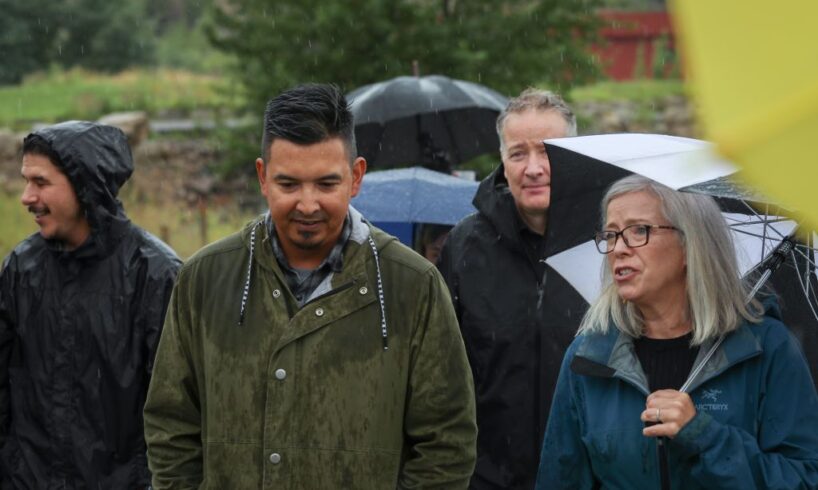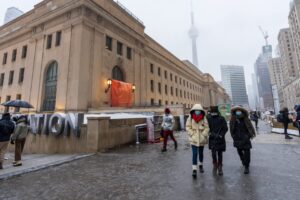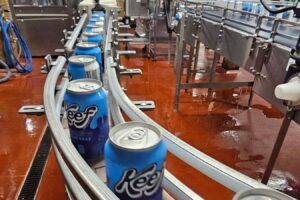
This story was produced in collaboration with IndigiNews.
As rain poured down on a stretch of endangered grasslands east of Kelowna, B.C., Westbank First Nation Councillor Jordan Coble guided guests to lay down tobacco.
“We’re going to create space for our animals, we’re going to create space for our winged creatures, our plant life and everything else that flows,” he said.
“We’re committing to that, right here, right now.”
On Wednesday, the B.C. and federal governments announced $8.3 million to support stewardship of ecological corridors in the province, including a long-standing effort to protect a key wildlife corridor in the Okanagan.
For several years, the B.C. and federal governments have been working with Indigenous Nations and conservation groups towards protecting at least 30 per cent of land and waters by 2030 — a commitment Canada made alongside 196 other countries at the global biodiversity conference in Montreal in 2022.
But healthy wildlife populations often require more than islands of protected habitat — they also need the ability to move safely between them.
sntsk’il’ntən-Black Mountain Regional Park protects a vital stretch of grasslands on Kelowna’s eastern slopes. sntsk’il’ntən, which means “place where flint is found” in nsyilxcən, is a sacred place for syilx people. For generations, these hills were used as a lookout. People harvested plants and medicines here and used flint to make arrowheads and other tools.
The funding announced Wednesday — $5.3 million from Parks Canada and $3 million from the province — will support work to identify, plan and improve corridors that link vital habitat patches in B.C., according to a joint government news release.
“Prioritizing biodiversity and ecosystem health is about more than protecting our natural spaces — it’s also about helping connect these spaces and removing barriers so that animals can move freely and safely,” Water, Land and Resource Stewardship Minister Randene Neill said in the release.
Initiative to protect wildlife corridor east of Kelowna highlighted
As part of the announcement, Neill and local member of Parliament Stephen Fuhr visited sntsk’il’ntən-Black Mountain Regional Park on the eastern slopes of Kelowna. sntsk’il’ntən, which means “place where flint is found” in nsyilxcən, is a culturally significant place for syilx people, who have long harvested plants for food and medicine and used the hillside as a lookout. The park also protects a key piece of a 65-kilometre-long, one-kilometre-wide wildlife corridor that stretches from Okanagan Mountain Provincial Park to k’nmalka, the Kalamalka Lake Provincial Park area.
The corridor is the last remaining stretch of connected, low elevation habitat between the two parks on the east side of Okanagan Lake — kɬúsx̌nítkʷ in the syilx language nsyilxcən — according to a 2023 action plan developed by the Okanagan Collaborative Conservation Program and the syilx Okanagan Nation Alliance to safeguard wildlife movement through the area.
“It’s no secret that the central Okanagan, the Okanagan as a whole, is a developing area far outpacing any other region within B.C., within Canada really,” Coble said at the event. With so much growth, “it’s very important to invest early in ecosystems and ecological corridors and habitat restoration.”
The Okanagan Mountain to k’nmalka wildlife corridor is one of the last stretches of connected, low elevation habitat between the two parks on the east side of Okanagan Lake. Map: Shawn Parkinson / The Narwhal
The key, Coble said, is collaboration and ensuring the work is guided by Traditional Ecological Knowledge.
“Migration has always been happening throughout our territory whether its animals, people, even plants and medicines will move throughout the valley as climate change takes place,” Coble said. “Creating a corridor so that animals can continue to move helps the ecosystem as a whole because it spreads the seeds of those medicines, spreads the seeds of those plants.”
According to the B.C. government, $70,000 was allocated to the Okanagan Collaborative Conservation Program for work in the corridor in the 2024-2025 fiscal year. Another $150,000 is being provided for 2025-2026.
The corridor spans grasslands, riparian areas and forests of ponderosa pine and Douglas fir, increasingly rare ecosystems in a region that’s seen rapid urban and agricultural development. While some portions of it, including sntsk’il’ntən, are already protected, other areas remain vulnerable to development.
Fuhr said the impacts of extensive development are notable. “Anyone who knows me in this area knows that I have a little plane and I fly up and down here all the time and you can literally see, between the urban sprawl and some of the fires we have, literally the animals and the wildlife that live along here are just getting squeezed out,” Fuhr said. “So the effort here to preserve a place for them is super, super important, and I think it’s well worth the investment.”
“We’re talking about keystone species — not just bighorn sheep and bears, but also badgers and raccoons and then the little reptiles as well. It’s incredibly important that they can use their territory as they were supposed to use it,” Neill added.
Parks Canada outlines priority areas for B.C. ecological corridors
The need to protect ecological corridors was included in the $1-billion nature agreement between Canada, B.C. and First Nations announced in November 2023. It promised action to conserve biodiversity and improve the ecological health of landscapes and watersheds across the province in the face of unprecedented global declines in nature.
Parks Canada identified several regions in B.C. as priority areas for ecological corridors to protect or restore habitat connectivity, including the South Okanagan to Thompson-Shuswap region, which encompasses the 65-kilometre Okanagan Mountain to k’nmalka wildlife corridor.
Urban and agricultural development in the Kelowna area has taken an immense toll on the rare and fragile ecosystems of the Okanagan Valley.
“The priority area is home to more rare, threatened and endangered species than anywhere else in British Columbia,” according to Parks Canada. But the federal agency warns there are only a few low-elevation travel corridors left in the region, and some are at risk of being lost.
“Maintaining existing connectivity and restoring lost connectivity between natural habitats in this priority area would be highly impactful for wildlife,” Parks Canada says on its website.
On its website, Parks Canada also notes that ecological corridors are local or regional initiatives through working landscapes, not federally protected areas like national parks. Other priority areas for ecological corridors in B.C. include southern Vancouver Island, the North Cascades to Fraser Plateau, Thompson-Fraser headwaters, the southern Rocky Mountains and the Upper Peace River region.





